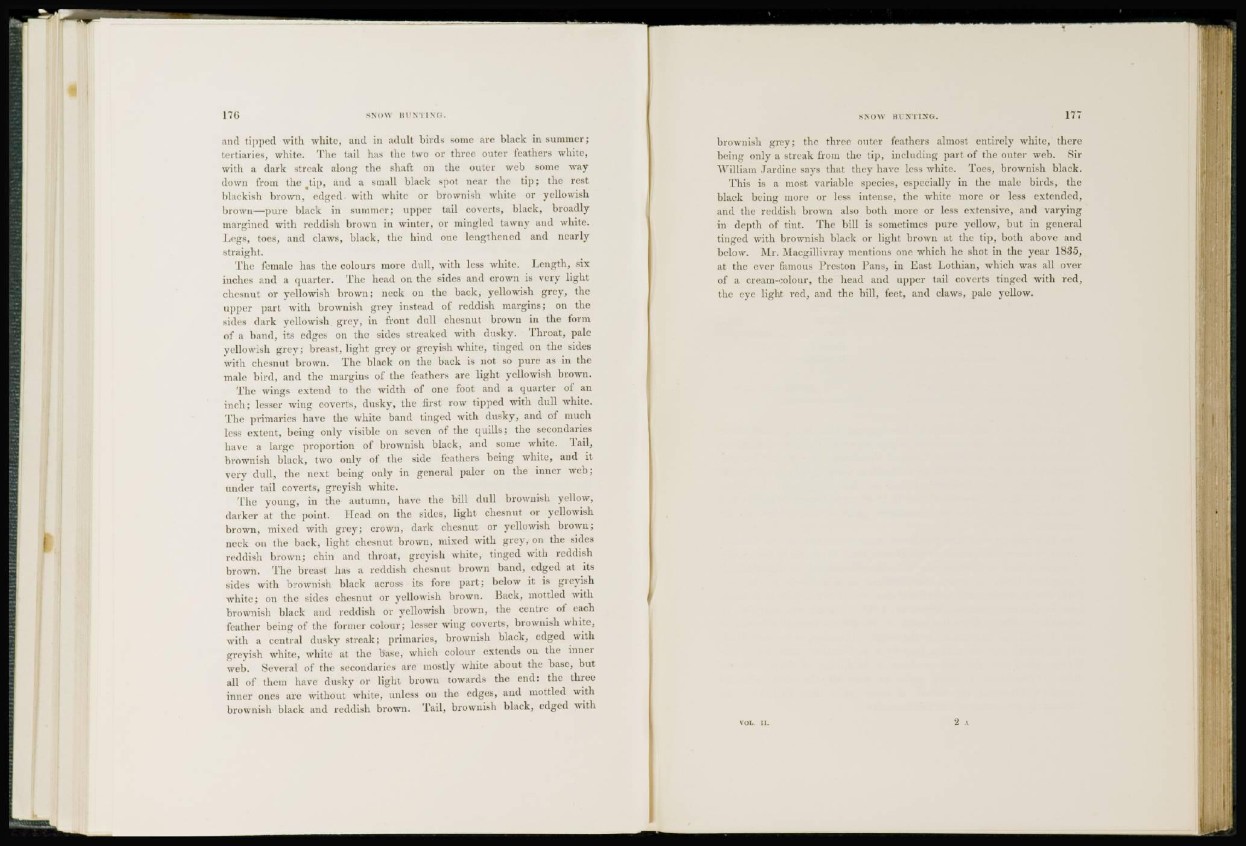
and tipped with white, and in adult birds some are black in summer;
tertiaries, white. The tail has the two or three outer feathers white,
with a dark streak along the shaft on the outer web some waydown
from the ttip, and a small black spot near the tip; the rest
hlarkish brown, edged with white or brownish white or yellowish
brown—pure black in summer; upper tail coverts, black, broadly
margined with reddish brown in winter, or mingled tawny and white.
I,egs, tors, and claws, black, the hind one lengthened and nearly
straight.
The female has the colours more dull, with less white. Length, six
inches and a quarter. The head on the sides and crown is very light
chesnut or yellowish brown; neck ou the back, yellowish grev, the
upper part with brownish grey instead of reddish margins; on the
sides dark yellowish grey, in front dull chesnut brown in the form
of a baud, its edges on the sides streaked with dusky. Throat, pale
yellowish grey; breast, light grey or greyish white, tinged on the sides
with chesnut brown. The black on the back is not so pure as in the
male bird, and the margins of the feathers are light yellowish brown.
The wings extend to the width of one foot and a quarter of an
inch; lesser wing coverts, dusky, the first row tipped with dull white.
The primaries have the white band tinged with dusky, and of much
less extent, being only visible on seven of the quills; the secondaries
have a large proportion of brownish black, and some white. Tail,
brownish black, two only of the side feathers being white, and it
verv dull, the next being only in general paler on the inner web;
under tail coverts, greyish white.
The young, in the autumn, have the bill dull brownish yellow,
darker at the point. Head on the sides, light chesnut or yellowish
brown, mixed with grey; crown, dark chesnut or yellowish brown;
neck ou the back, light chesnut brown, mixed with grey, on the sides
reddish brown; chin and throat, greyish white, tinged with reddish
brown. The breast has a reddish chesnut brown band, edged at its
sides with brownish black across its fore part; below it is greyish
white; on the sides chesnut or yellowish brown. Back, mottled with
brownish black and reddish or yellowish brown, the centre of each
feather being of the former colour; lesser wing coverts, brownish white,
with a central dusky streak; primaries, brownish black, edged with
greyish white, white at the base, which colour extends on the inner
web. Several of the secondaries are mostly white about the base, but
all of thcin have dusky or light brown towards the end: the three
inner ones are without white, unless on the edges, and mottled with
brownish black and reddish brown. Tail, brownish black, edged with
brownish grev; the three outer feathers almost entirely •white, there
being only a streak from the tip, including part of the outer web. Sir
William Jardine says that they have less white. Toes, brownish black.
This is a most variable species, especially in the male birds, the
black being more or less intense, the white more or less extended,
and the reddish brown also both more or less extensive, and varying
in depth of tint. The bill is sometimes pure yellow, but in general
tinged with brownish black or light brown at the tip, both above and
below. Mr. Macgillivray mentions one which he shot in the year 1835,
at the ever famous Preston Pans, in East Lothian, wdiich was all over
of a cream-colour, the head and upper tail coverts tinged with red,
the eye light red, and the bill, feet, and claws, pale yellow.
VOL. II.